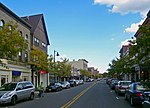La Fetra Mansion

La Fetra Mansion located in Summit, New Jersey, United States, is a mansion designed and built for industrialist H. A. LaFetra of the Royal Baking Powder Company (known today as NJR Nabisco Company) by Henry Bacon (November 28, 1866 – February 17, 1924), the same year he founded his architectural firm, Brite and Bacon. He is best known for his last work, the Lincoln Memorial in Washington, D.C. Since its completion in 1899, this mansion has been owned by industry leaders. The home, with 8,000 square feet (740 m2) of living space on the first two floors, and more than 2,000 square feet (190 m2) on the third floor, was featured in the September 1901 issue of Architecture Magazine, the professional journal of the industry. It has been one of the premier properties in this area for over a century.
Excerpt from the Wikipedia article La Fetra Mansion (License: CC BY-SA 3.0, Authors, Images).La Fetra Mansion
Ridge Road,
Geographical coordinates (GPS) Address Nearby Places Show on map
Geographical coordinates (GPS)
| Latitude | Longitude |
|---|---|
| N 40.724484 ° | E -74.354782 ° |
Address
Ridge Road 74
07901
New Jersey, United States
Open on Google Maps










